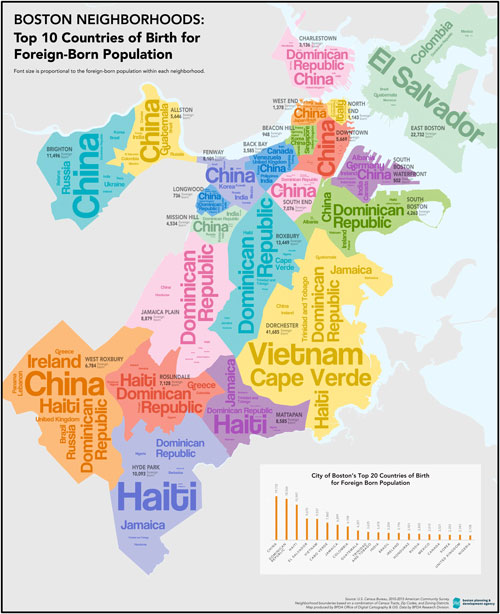The demand for translation and interpreting services in Massachusetts is growing – and you should take notice. This is especially true if you run a business or provide services to the community. As demand for language services increases, with it does the population of foreign born individuals participating in the local economy and community. This can entirely change the way you reach out to and interact with the local market…
Translation Services in Massachusetts are growing…
Whether you know it or not, the market for interpreting and translation services in Massachusetts is growing. This is seen both in the demand for language services, and bilingual employees in the area.
You may think that this information doesn’t affect your business, or even your industry, but in all likelihood most companies and service providers – especially those that are client facing – will feel this impact.
Why?
An increase in demand for language services tends to directly relate back to growth in multilingual and multicultural populations. This is due to the fact that the way people interact with businesses, products, day to day services, and even each other will change when different cultures and languages intermingle.
While some businesses understand this fact, there are still those that aren’t yet looking to develop a robust strategy to connect with these multilingual communities – largely comprised of immigrants.
However, most industries would do well not to ignore the buying power of immigrants and LEP individuals. Nationwide, Latino and Asian individuals (both foreign and domestic born) make up the largest percentage of minority purchasing power.
Just how much of the country’s purchasing power do they represent? According to a report in The Atlantic,
Latinos represent $1.3 trillion in purchasing power, and Asian Americans currently represent roughly $825 billion – expected to grow to $1.1 trillion by 2020.
While this presents a huge opportunity, and a simple translation of materials is the way to go, there are larger barriers in terms of language and culture within these economically powerful groups.
Cultural and Linguistic Differences

They would also be forgetting the fact that Asian Americans hail from numerous countries with completely different languages and cultural backgrounds (coupled with the differences between Western and Eastern cultures).
Currently, Indian-Americans represent the wealthiest Asian-American minority group, but it is also comprised of individuals from China, Vietnam, Korea, and the Philippines.
But how do these opportunities, as well as challenges, scale back down to a local level – impacting Massachusetts’ communities – particularly the Boston area?
Translation Services in Massachusetts | The Shifting Demographics of Massachusetts and Boston
Between 1990 and 2015, the overall percent change in the immigration population of Massachusetts was +11.4%. By 2015, 9% of the total population of Massachusetts was also considered Limited English Proficient (LEP).
When it comes to breaking down these facts in terms of more specific cultural and linguistic backgrounds, the statistics (as reported by Data USA for the year 2015) are as follows:
What are the three most common birthplaces for international individuals in Massachusetts?
- China
- The Dominican Republic
- Brazil
What are the 2 most common languages among Non-English speaking individuals?
- Spanish
- Chinese
What are the most common races and ethnicities reported in the Boston area?
- White
- Black
- Hispanic
You can get a better idea of how the disbursement of the foreign born population in the city of Boston looks from the map below:
What does this mean for Boston and Massachusetts as a whole?
Comparing these demographics to the national trends in minority purchasing power, the city and the state have the opportunity to reach out to some of the most economically powerful, and growing, groups in the nation.
This means connecting with immigrants and multilingual individuals, both at a cultural and a linguistic level, and businesses taking a good look at adapting their brand messages’ in response.
Translation services in Massachusetts thus become important when local businesses realize the potential these markets have.
Economic reasons aside, Boston and cities around the state are also solidifying themselves as refuges, welcoming immigrants.
Massachusetts Policy Changes Regarding Immigration

Massachusetts towns and cities, including Boston, are in that mix of locals declaring that they will protect the immigrants living in their communities, and will not go along with increasingly conservative federal immigration policies.
As such, the need to adapt institutions such as healthcare, academia, and local government access to better represent these communities will no doubt continue to grow – as will the need for translation services in Massachusetts. The takeaway?
Higher and Protected Immigration = Greater Need For Businesses And Services To Communicate = Growth for Language Services
One of the major drivers of the language services industry nationally (unsurprisingly) is the rising number of immigrants in the country, and the industry as a whole is projected to grow 4.4% between 2017 and 2022 (IBIS World).
The same can be applied for the growth of interpreting and translation services in Massachusetts.
With Boston alone currently home to 177,563 foreign born residents (as of 2015), and its city officials vowing to protect all immigrant members of the community, certified document translation services and interpretation needs will no doubt increase in the area across a variety of sectors. It can be assumed this will be felt statewide too.
In other words, no matter what your industry, it is likely you will need to communicate on a more personal level with non-English speaking immigrants within the very near future. Else you risk missing out on individuals that are economically powerful, and also risk alienating members of your own community.
That being said, how do you begin reaching these communities?
How Do You Connect With Multilingual and Multicultural Communities?

But it’s never that easy.
That’s because simply translating and interpreting won’t be enough to truly connect with an individual from a different cultural background. Adapting your branding and client interaction through the help of cultural awareness as well as localization is thus necessary – and often this requires a full blown strategy and participation from everyone you work with.
Dedicating your business to reaching out to immigrant and multilingual communities will not just help you reach them, it will help consumers be more persuaded to consider your brand (as research as shown 75% of online consumers prefer to buy from businesses advertising in their native language) and help LEP individuals access vital services.
The following are important to take into account when planning a multilingual strategy for your clients and contracting translation services in Massachusetts (or anywhere):
- Translating all relevant marketing materials and user/instructional manuals
- Localizing ad campaigns and online resources to appeal to multicultural markets
- Providing professional interpreters for services requiring direct client-employee interaction
- Investing in cultural training for employees – especially those that help provide a vital service to LEP and immigrant populations
As the demographics of Massachusetts, and the country as a whole, continue to become more diverse, now is the time to consider a multilingual strategy for your business or service!
Sources:
- MPI Data Hub Number and Share of the LEP Population in United States, 1990 to 2015
- MigrationPolicy.org – Immigrant Population State 1990-Present
- MigrationPolicy.org – Language Diversity and English Proficiency in the US
- American Immigration Council – The Economic and Political Power of Immigrants, Latinos and Asians
- Data USA – Boston
- WBUR News – More Communities Adopt Sanctuary Cities
- Census Reporter – Boston
- IBIS World – Language Services Inudstry
- US Census American FactFinder – Boston
- Common Sense Advisory – Survey of 3000 Online Shoppers
- Boston Globe – Bilingual Employees in Demand
About Language Connections:
Language Connections is one of the top language service companies in the US. Over the last 30 years, we’ve focused on providing the best business translation services, interpreting services, as well as interpreter training and customized language training programs. In addition to top-tier corporate language training, we offer certified corporate interpreters and professional business translation services in 200+ languages. Our network includes linguists with backgrounds in all major industries. They’re ready to meet your needs, whether they’re for technical translation services, legal translation, government translation services, international development translation services, education translation services, life sciences translation, or something else. Reach out to us today for a free quote on our cost-efficient and timely translation services, interpreters, or other linguistic services.
Language Connections Inc.
2001 Beacon Street, Suite 105,
Boston, MA 02135
Phone: +1-617-731-3510
Email: service@languageconnections.com



